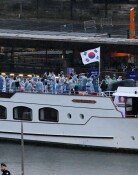[Opinion] Yongsan Army Base
Some say that the name Yongsan came from the shape of the mountain in the area that looks like a dragon. Others say that the name came from the story of two dragons once appearing in the Han River. Yongsan, located in the center of the capital city of Seoul, is believed to be a lucky place surrounded by Mountain Nam in the north and the Han River in the south. In Chosun Dynasty, Yongsan, along with Mapo, is a home for riverside merchants who carried packets of rice for the ruling Yangban class. It was also a key spot in shipping collected taxes to the central government. Japan, having sent its armed force to Chosun at the time of the 1882 Imo Revolt, chose Yongsan among three candidates including Mapo and Yanghawjin (now Hapjung-dong) to open an outdoor market.
▷Yanghwajin, being a small village, was not qualified to become a port town for trade, and Mapo was too crowded with houses to be developed into a port, they said. Yongsan, about 10 ri (about 4km) apart from Namdaemun Gate, offered even road conditions for wheel transportation. Most of the area was filled with open fields and the river ran deep enough to accommodate big vessels. In 1884, an area connecting Yongsan through Mapo was designated as an open market for foreign trade and residence. When missionaries were allowed to enter the country in 1887, French, Chinese and Japanese people flocked in large numbers for missionary and commercial activities.
▷It was around the 13th century when foreign armies first entered Yongsan. The Mongolian force invaded the late Korea Dynasty and used this area as a logistics base. During Imjin War, the Japanese soldiers set up their base camp along Wonhyo-ro and Cheongpa-dong. Some 3,000 Chinese soldiers from Chung Dynasty stationed in the area during the 1882 Imo Revolt, and later during the 1904 Russian-Japanese War, the Japanese colonial army seized some 3 million pyong-scale of land in Yongsan. After independence, 15,000 personnel from the U.S. Seventh Division took back the land from the Japanese, which was later developed into the U.S. army command in Korea of today. It has been a century since the Japanese army first set up a base in Yongsan. Itaewon, a place located near Yongsan and known as a foreign district in Korea, has a meaning of a place with different kind of birth, which indicates its origin as a prostitute spot.
▷Yongsan, which was filled with open fields at the time the Japanese set up a base, has then become a part of the center of Seoul connecting the northern and the southern area between the Han River. As the presence of the foreign army base is now considered humiliation to national pride and a barrier to urban development, the two countries have begun to discuss relocation of the army base. It will, however, take some 10 years and a huge amount of money to completely relocate the base. When the administrative capital of the country moves to Chungcheong-do, the humiliating part of the reason will lose its appeal more or less. The plan then might enter a new phase.
Hwang Ho-taek, Editorial Writer, hthwang@donga.com







